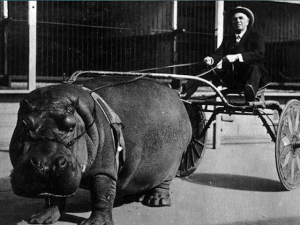greek

 The Hippopotamus is a large, lumbering animal found mostly in Africa, or in zoos in other places. These animals are rather hot blooded and since Africa is often hot too, the like to spend much of their day almost totally immersed in water in an effort to stay cool. The hippopotamus has a bulky body with stumpy legs, an enormous head with a mouth to match, a short tail, and four toes on each foot. Each of the toes has a nail-like hoof. Male hippos are usually about 11.5 feet long, stand 5 feet tall, and weigh 3.5 tons…yes that’s tons…strange considering their relatively short stature. The males are the larger gender in terms of physical size, weighing about 30 percent more than females. The nearly hairless skin is 2 inches thick on the flanks, but thinner elsewhere. Hippos are grayish brown in color, with pinkish underparts. Their huge mouth is half a meter wide and can gape 150° to show the teeth. When the mouth is open, the head almost completely disappears. The lower teeth are very sharp and can be more than 12 inches long.
The Hippopotamus is a large, lumbering animal found mostly in Africa, or in zoos in other places. These animals are rather hot blooded and since Africa is often hot too, the like to spend much of their day almost totally immersed in water in an effort to stay cool. The hippopotamus has a bulky body with stumpy legs, an enormous head with a mouth to match, a short tail, and four toes on each foot. Each of the toes has a nail-like hoof. Male hippos are usually about 11.5 feet long, stand 5 feet tall, and weigh 3.5 tons…yes that’s tons…strange considering their relatively short stature. The males are the larger gender in terms of physical size, weighing about 30 percent more than females. The nearly hairless skin is 2 inches thick on the flanks, but thinner elsewhere. Hippos are grayish brown in color, with pinkish underparts. Their huge mouth is half a meter wide and can gape 150° to show the teeth. When the mouth is open, the head almost completely disappears. The lower teeth are very sharp and can be more than 12 inches long.
Hippopotamus is Greek for “river horse” mainly because of their love of water. So much do they love the water, that Hippos spend up to 16 hours a day submerged in rivers and lakes to keep their massive bodies cool under the hot African sun. As clumsy as they might seem on land, hippos are graceful in water, good swimmers, and can hold their breath underwater for up to five minutes. Often, in the shallow lakes, hippos are large enough to simply walk or stand on the lake floor or lie in the shallows. Because their eyes and nostrils are located high on their heads, they have the ability to see and breathe while mostly submerged. While they spend a lot of time in the water, hippos also like to enjoy the sun on the shoreline and strangely, their bodies secrete an oily red substance, which is where the myth that they sweat blood came from. The liquid is actually a skin moistener and sunblock that may also provide protection against germs. What most people wouldn’t give to have built in moisturizer and sunblock…well, maybe not a heavy sunblock. Hippos come out of the water at sunset and begin their nightly feeding cycle. Often traveling up to six miles, they consume up to 80 pounds of grass. Now, that’s a lot of carbs, but given their size, that is not that much food. Hippos seem like a slow animal, but if they are threatened on land hippos may run for the water, and they can match a human’s speed…for short distances.
In the past, hippos have been used to pull a cart, much like a horse. I suppose it was a common site in Africa, 
 but for most of us today, it would be a strange sight indeed. There was a hippo in the Barnes Circus, names Lotus. Lotus was an obedient cart hippo, but I’m not so sure she was very happy about that cart that was hooked on behind her. It makes sense that she would be unhappy, she was in captivity, and that she couldn’t have been happy with her life. I wonder what would happen if Lotus had been spooked near a pond. My guess is that there would have been one wet driver.
but for most of us today, it would be a strange sight indeed. There was a hippo in the Barnes Circus, names Lotus. Lotus was an obedient cart hippo, but I’m not so sure she was very happy about that cart that was hooked on behind her. It makes sense that she would be unhappy, she was in captivity, and that she couldn’t have been happy with her life. I wonder what would happen if Lotus had been spooked near a pond. My guess is that there would have been one wet driver.

